NBN Rollout Progress
Introduction
2.1
This chapter provides an overview about the current status of the
National Broadband Network (NBN) rollout, drawing on information from the nbn Corporate
Plan 2017, Corporate Plan 2018-21 and other reports published by
nbn. With particular reference to the Statement of Expectations, the chapter
also outlines the evidence received about progress of the rollout, activations
rates, and planning and prioritisation of the rollout.
Stated goals of the rollout
2.2
nbn's Statement of Expectations, issued by the two Shareholder Ministers
on 24 August 2016, outlines the overarching policy objectives for the rollout
of the NBN:
The Government is committed to completing the network and
ensuring that all Australians have access to very fast broadband as soon as
possible, at affordable prices, and at least cost to taxpayers. The Government
expects the network will provide peak wholesale download data rates (and
proportionate upload rates) of at least 25 megabits per second to all premises,
and at least 50 megabits per second to 90 per cent of fixed line premises as
soon as possible. nbn should ensure that its wholesale services enable retail
service providers to supply services that meet the needs of end users.
To achieve these objectives nbn should roll out a
multi-technology mix network and build the network in a cost effective way
using the technology best matched to each area of Australia. nbn will ensure
upgrade paths are available as required.[1]
2.3
According to nbn's Corporate Plan 2018-21, nbn's key goal is to
activate 8.6 million homes and businesses to the NBN by 2021, with a Ready
for Service (RFS) footprint of 11.7 million premises.[2]
The estimated number of RFS premises by the end of FY2020 has been revised
downward by 0.3 million from the figure included in the Corporate
Plan 2017.[3]
2.4
On 1 August, representatives of the Department of Communications and the
Arts (the Department) stated:
In the government's statement of expectations to the company,
the parameters that have been set—which the company is designing its network to
comply with—are the delivery of 25 megabits per second to all Australians, and
the availability of 50 megabits per second or more to 90 per cent of the fixed
line network. They are the firm parameters in the statement of expectations.[4]
2.5
It is interesting to note that in answers to questions on notice, nbn
has advised that 35 per cent of FTTN premises are getting 50 megabits per
second or less.[5]
If this ratio is extrapolated it will ultimately equate to 1.61 million
premises and means that 15 per cent of the 10.7 million fixed line premises
will receive 50 megabits per second or less. On that basis the network
will not comply with the government's Statement of Expectations.
2.6
This forecast is based on an assumed take-up rate across residential and
business areas by 30 June 2020 to be at approximately 70 per cent which is a
greater take-up rate than is currently being met across all platforms. The Corporate
Plan 2017 notes that full take up is constrained by factors such as:
proportion of people requiring mobile-only products, vacant premises and fibre
alternatives. nbn also forecasts that beyond financial year 2020 (FY20),
take-up rate will increase to 73 – 75 per cent.[6]
Status of the rollout
2.7
nbn publishes data about the NBN rollout in weekly progress reports,
annual reports and corporate plans. The progress of the rollout is primarily
monitored in two ways:
-
number of premises Ready For Service (RFS)—premises
passed by the active NBN and are available for connection by consumers; and
-
number of activations—premises where a customer has signed
up to an NBN service.
2.8
This next section provides information about the status of the rollout, using
RFS and activation figures as published in the Corporate Plan 2017, Half
Year Report 2017, Third Quarter Results, Full year results 2017 and
Corporate Plan 2018-21.
Rollout progress to 30 June 2016
2.9
nbn's Corporate Plan 2017 reported figures for financial year
2016 (1 July 2015 to 30 June 2016):
-
Cumulative figures to the end of financial year 2016 (FY2016):
-
2,893,000 premises categorised as RFS; and
-
1,099,000 premises activated.
-
Annual figures for financial year 2016:
-
1,700,000 premised categorised as RFS; and
-
more than 600,000 premises activated.
Projections for Financial Year 2017
2.10
The Corporate Plan 2017 included projections for rollout progress
at the end of Financial Year 2017 (FY17) and until the end of the rollout in
2020. According to the nbn projections, a total 5.4 million premises would
be RFS and 2.3 million premises activated by the end of FY17.[7]
2.11
The number of premises RFS and activated would vary across technology
type, as detailed in Table 2.1.
Table 2.1: Premises Ready for
Service and activated—technology type[8]
| |
Premises
RFS – cumulative (millions) |
Premises
activated – cumulative (millions) |
| |
FY16
(A) |
FY17 |
FY16
(A) |
FY17 |
| FTTP Brownfields |
1.1 |
1.1 |
0.7 |
0.8 |
| FTTP Greenfields |
0.3 |
0.4 |
0.2 |
0.2 |
| FTTN |
0.7 |
2.1 |
0.1 |
0.9 |
| HFC |
0.0 |
0.9 |
0.0 |
0.1 |
| Fixed Wireless |
0.4 |
0.5 |
0.1 |
0.2 |
| Satellite |
0.4 |
0.4 |
0.0 |
0.1 |
| Total |
2.9 |
5.4 |
1.1 |
2.3 |
Note: (A) denotes actual figures
from FY16
Current figures—Rollout progress to
30 June 2017
2.12
NBN rollout figures to the end of FY17 report that 5,713,000 premises
are RFS and 2,443,000 premises have been activated. Figure 2.1 provides the
cumulative RFS and activation figures for the 2014, 2015, 2016 and 2017
financial years as well as the projected figure included in the Corporate
Plan 2017.
Figure 2.1: Cumulative
premises RFS and activated[9]
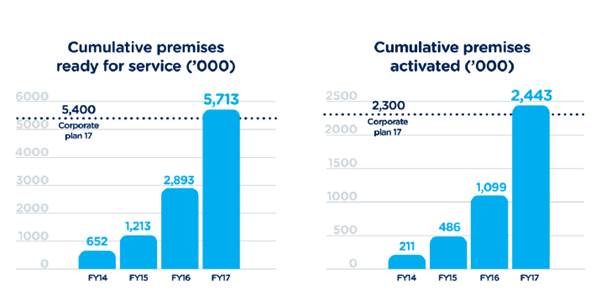
2.13
Figures 2.2 and 2.3 below provide the quarterly cumulative RFS and
activation figures from the end of FY16 to the end of FY17 by technology.
Figure 2.2: Cumulative
premises ready for service by quarter (by technology)[10]
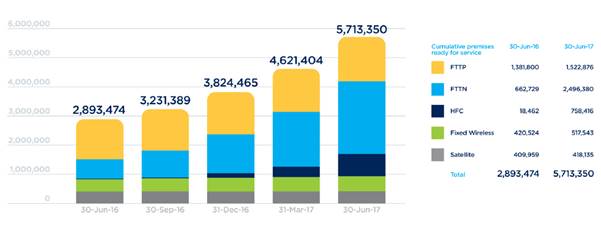
Figure 2.3: Cumulative active
end users by quarter (by technology)[11]
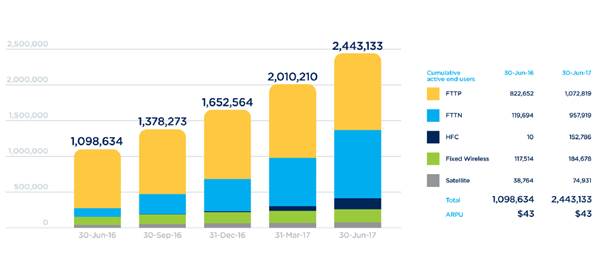
Projections for Financial Year 2018
and beyond
2.14
The Corporate Plan 2018-21 includes projections for rollout
progress for the end of Financial Year 2018 (FY18) and beyond. The number of
premises RFS and activated would vary across technology type as detailed in
Table 2.2 and 2.3.
Table
2.2–Premises Ready for Service by technology type[12]
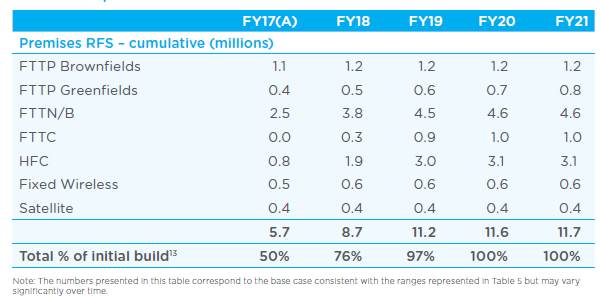
Table
2.3–Premises activated by technology type[13]

2.15
At the public hearing in Canberra on 23 June 2017, the committee
discussed with officers from the Department the risks to the project in terms
of the rollout:
In terms of the rollout, the risks would relate to
maintaining the run rate that the company has achieved. Over time, in order to
reach its target of connecting all customers by 2020, the company has needed to
increase the deployment rate it has achieved on a regular basis. It is now
improving that run rate up to the point at which it is deploying to customers.
Maintaining that high speed of deployment will be one of the key objectives of
the company.[14]
Rate of activation
2.16
According to nbn, once an area reaches the disconnect date (that is, 18
months after it becomes ready for service), approximately 75 per cent of
consumers able to connect to the NBN are connecting. The take up percentage is
similar for FTTP and FTTN premises.[15]
At that point, a person who hasn't switched to the NBN would have no access to
line broadband or an ADSL telephone connection, and could only be relying on
mobile telephony and data.
2.17
However, at 30 June 2017, according to the Corporate Plan 2018-2021,
there were 2.4 million activated premises out of the 5.7 million premises that
are ready for service, which is an activation rate of only 42 per cent.[16]
Cost per premise per technology
2.18
In the Full Year Results 2017, nbn reported the cost per premises
for each technology for FY16 and FY17.
Figure 2.4: Cost per premises[17]
![Figure 2.4: Cost per premises[17]](~/media/Committees/nbn_ctte/first_report/c02_6.jpg)
2.19
With respect to the cost per premise for FTTC, nbn advised the committee
that the company estimates that the cost will be approximately $2,800-$2,900
per premise.[18]
Progress of rollout and revenue
generation
2.20
In meeting the policy objectives outlined in the Statement of
Expectations, nbn is required to 'operate its business on a commercial basis'.[19]
2.21
The committee heard evidence about the need for nbn to encourage take up,
in particular on higher speed plans, in order to facilitate cost recovery and
returning a profit. Mr Bill Morrow, Chief Executive Officer, nbn, stated:
Building a network quickly at a lower capital cost and
bringing forward revenue has huge advantages not only for Australians getting a
service sooner but also for the NBN in terms of the economics. We can use that
revenue to fund future upgrades if and when the demand emerges.[20]
2.22
Mr Andrew Madsen, Assistant Secretary, Broadband Implementation Branch,
Department of Communications and the Arts also provided evidence about nbn's
revenue:
There is a lot happening there in terms of how NBN produces
revenue. Certainly the rate of the rollout and the period at which people sign
up and then start paying costs to their retail service provider and that
revenue is then collected by the company is one factor. But at the same time
the company is also developing new products, it is expanding the services it is
providing into the business market, and also, as well as the level of
activation increasing significantly, the other factor we are seeing is that
there is more data being used by consumers and as a consequence more data that
needs to be purchased by retail service providers. So the revenue per user is
growing at the same time that the number of users on the network is growing as
well.[21]
2.23
In the Corporate Plan 2017, nbn reported FY16 revenue of $421
million which was a 157 per cent increase compared to FY15. nbn also projected
that by FY20, revenue will have grown by 12 times compared to FY16, as shown in
Figure 2.5 below.
2.24
It is notable, however, that CEO Bill Morrow has publicly expressed
concern about future revenue, and, in the Corporate Plan 2018-21 the
forecast revenue for FY19 is revised down to $3.5b and the forecast revenue for
FY20 is revised down to $4.9b.[22]
Figure 2.5: Revenue projection published in Corporate
Plan 2017[23]
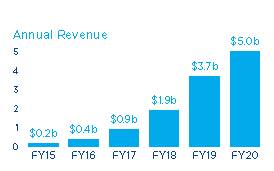
2.25
The Corporate Plan 2018-21 provides updated revenue projections.
Figure
2.6: Revenue projection published in Corporate Plan 2018-21[24]
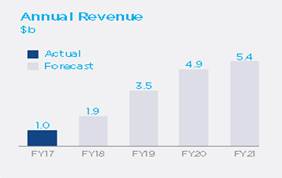
2.26
In the Full year results 2017, nbn reported FY17 revenue of $1,001
million which was a 138 per cent increase on FY16. Total revenue by quarter by technology
is shown in Figure 2.7.
Figure 2.7: Total revenue by
quarter (by technology type)[25]
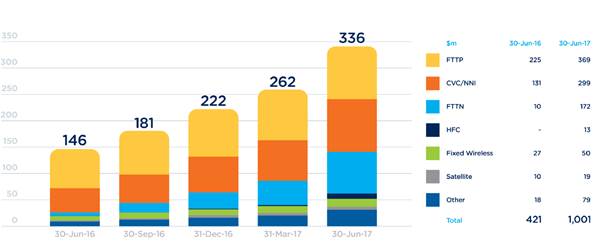
2.27
When asked to assess whether FTTN or FTTC deliver a higher net present
value in terms of the incremental investment over the life of the asset, Mr Stephen
Rue, Chief Financial Officer, nbn advised:
Without having figures in front of me, I would venture to say
FTTN would, because, the quicker the revenue comes on board it enables us to
upgrade as and when consumers are willing to pay more because they need higher
speeds.[26]
2.28
While a clear answer could not be given as to whether it was more costly
in terms of capital expenditure to rollout FTTN and subsequently fund an
upgrade, as opposed to delivering FTTC or FTTP at the outset, nbn CEO Bill
Morrow suggested it would be more costly:
I think you've got to look at the full context of that. It
would be silly for somebody to say that those two costs added together are
cheaper, but it is an issue around where the cash flow management is coming
from, or it should be.[27]
2.29
Mr Morrow confirmed that nbn had not made provision for a network
upgrade within the existing funding envelope.[28]
2.30
The committee heard evidence from a number of witnesses to the effect
that the cost-per-premise of FTTP has decreased by as much as 40 per cent in
the course of the rollout in other countries.[29]
It appears the per premise cost that nbn attributes to FTTP has not changed
since 2013.[30]
2.31
Revenue projections with respect to upgrade pathways are discussed later
in this chapter.
Progress of rollout by jurisdiction
2.32
Figure 2.8 below shows the progress of the rollout by jurisdiction as
set out in the Corporate Plan 2018-21.
Figure 2.8–Progress of
rollout by jurisdiction[31]
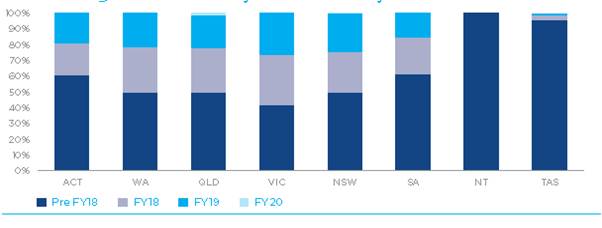
2.33
Evidence to the inquiry described variations in rollout progress and
technology composition across jurisdictions.
2.34
The Northern Territory Government advised:
Looking at that in percentages of the population terms and
comparing it to the rest of the Australian population: 93 per cent of the
population nationally has a terrestrial connection, and it will be 65 per cent
of the Northern Territory population; three per cent nationally have a fixed
wireless connection, and it is going to be six per cent in the Northern
Territory; and four per cent nationally have a satellite connection, and it
will be 29 per cent of our population in the Northern Territory. That means for
us that 71 per cent of the Northern Territory's population will receive
high-speed, high-capacity broadband services and almost one-third of Northern
Territory residents will need to rely on satellite services in the future.[32]
2.35
In its submission the Queensland Government stated:
As at 16 February 2017 (the latest NBN Co. roll out
information), 597,203 premises in Queensland have been declared Ready for
Service by the NBN Co. and 270,132 (45 percent) premises have been activated
using FttP, FttN and HFC technologies.
...
At 16 February 2017, 33 per cent of the premises covered by
wireless in Queensland have been activated. The fixed wireless roll-out is
reported to be generally reliable, and on, or ahead of schedule. The reported
speeds are very close to what customers have been promised by service
providers.
At 16 February 2017, 16 per cent of the premises covered by
satellite in Queensland have been activated.[33]
2.36
The ACT Government's submission to the inquiry expressed concern about
the pace of the rollout in the ACT which is 'resulting in a rising degree of
frustration from Canberra businesses and residents'. The submission noted:
As of 23 June 2016, NBN has rolled out its FTTN and satellite
technology to 54,123 premises around the ACT, and by January 2017 around 42,000
premises had active NBN connections. This is an increase of just 22,000
premises over three years since December 2013. While these connections are a
mixture of FTTN and FTTP technologies, it has been determined that FTTN
technology will be used in future ACT NBN installations.[34]
2.37
The South Australian Government submitted:
In a South Australian context, at the end of 2016, more than
308,000 premises had access to the NBN, of which 38 per cent (118,000 premises)
have taken up an NBN service. While the take-up rate in SA is slightly lower
than the national rate, it is pleasing to see that the rate of service
availability in South Australia is on a par (32 per cent nationally versus 31 per
cent in SA) with the national rollout after an initial slow start in this
State.[35]
2.38
The Western Australian Government provided evidence about the rollout in
that state:
In the last few months, while the rollout has progressed in
Western Australia, the take-up rate has dropped. From almost 42 per cent in
April, it is now 39 per cent in July. In the same period, the number of homes
rated as service class 0 has increased from 3.1 per cent to 4.7 per cent. Now
over 23,000 homes are unable to get any services at all, and the number
increases at around 2,000 homes per week.[36]
User demand, usage patterns and trends
2.39
In April 2017 the Australian Bureau of Statistics (ABS) released its
Internet Activity Report for the three months to 31 December 2016, detailing
the extent of internet connections in Australia:
There were approximately 13.5 million internet subscribers in
Australia at the end of December 2016. This is an increase of 4.7% from the end
of December 2015. Fibre continues to be the fastest growing type of internet
connection in both percentage terms and subscriber numbers. The number of fibre
connections increased to more than 1.4 million connections, which is an
increase of 122% in the year between December 2015 and December 2016.[37]
2.40
In terms of the volumes of data downloaded, the ABS found:
The total volume of data downloaded in the three months ended
31 December 2016 was 2.6 million Terabytes (or 2.6 Exabytes). This is a
23.3% increase in data downloads when compared with the three months ended 30
June 2016 and a 50.8% increase in the year between December 2015 and December
2016.
Data downloaded via fixed line broadband (2.5 million
Terabytes) accounted for 98% of all internet downloads in the three months
ended 31 December 2016.[38]
2.41
Concurrently with the release of the ABS's Internet Activity Report, nbn
also released information about downloads on the NBN. nbn noted that the
average home was downloading 117GB per month, however:
Homes connected to services over the [NBN] are downloading
around 144GB of data each month which is a 32 per cent year-on-year
increase and around 1.2 times the national fixed-line average and 76 times
the mobile average.[39]
2.42
The committee received evidence from individuals and organisations about
how they are using the NBN and the internet more broadly. Witnesses and submitters
discussed activities such as internet banking, accessing government services,
connecting with family and friends via social media as well as running a small
business and completing school and university studies.[40]
2.43
The Queensland Government submitted:
The NBN is also used for
entertainment and recreation services such as downloading movies (e.g. Netflix,
Foxtel), and this is sometimes dismissed as an inappropriate or unimportant
usage of the NBN. However, just as the use of road and transport infrastructure
for the purposes of entertainment or recreation is completely acceptable, use
of the NBN for these purposes can be an important social good.[41]
2.44
The committee also received evidence that the community is increasingly
using the NBN for uploading as well as downloading including: cloud based
applications, such as accounting packages, agricultural and harvest recording
as well as cloud storage.[42]
2.45
Ms Louise Denoon, Executive Director, Regional Access and Public
Libraries, State Library of Queensland, explained that a high volume of content
at some libraries is accessed online:
... the State Library of Queensland, for instance, with its
collections that it provides—that is different to public libraries—would be in
the order of 90 per cent accessed online and digitally compared to using
physical resources. It still means the libraries are very busy places where a
lot happens, but accessing information happens, and people want it anytime,
anywhere.[43]
2.46
Further evidence about the utilisation of the NBN is discussed further
in Chapters 3, 4 and 8 of the report.
Choice of plan
2.47
Consumers signing up to a NBN service are required to choose a service
based on the speeds available for download and upload. This option has not
previously been available on ASDL services. Table 2.4 shows the plan speeds
currently available and the take up rate across fixed line, fixed wireless and
satellite (as at 30 June 2016 and 30 June 2017).
Table 2.4: Percentage of users on available speed tier plans[44]
| Speed tier mix
(Mbps) |
Fixed line |
Fixed wireless |
Sky Muster |
| 30/6/16 |
30/6/17 |
30/6/16 |
30/6/17 |
30/6/16 |
30/6/17 |
| 12/1 |
32% |
29% |
16% |
16% |
26% |
34% |
| 25/5 |
49% |
53% |
81% |
78% |
74% |
66% |
| 25/10 |
1% |
1% |
N/A |
N/A |
N/A |
N/A |
| 50/20 |
4% |
4% |
3% |
6% |
N/A |
N/A |
| 100/40 |
14% |
13% |
N/A |
N/A |
N/A |
N/A |
2.48
At the public hearing in Sydney, Mr Bill Morrow, Chief Executive
Officer, nbn, emphasised that the majority of consumers are signing a contract
for an NBN service on a plan for 25Mbps or less:
People say they would be happy with 25 [Mbps]. Remember, 30
per cent of the people on the network are only are getting 12 and another 50
per cent are getting 25. And 25, typically, is sufficient for most.[45]
2.49
When discussing the range of speed options available to consumers,
Mr Morrow advised that the 12 Mbps product was never designed for
broadband:
It was designed for a voice-based product in case somebody in
a home says: 'I don't want to surf the internet over that network; I'll use my
mobile device or nothing. I just want a phone service.' The 12-meg [Mbps]
product was created for that. Now it's suddenly being used because it is
cheaper than a 25 product, as this is your high-speed broadband NBN-enabled
product out there, and I can actually have a lower cost because I'm only paying
NBN $24 a month for this versus $27 to ratchet up to a 25 meg [Mbps].[46]
Rollout timetable and
prioritisation
2.50
The Statement of Expectations includes the following requirements for
planning the rollout:
When planning the rollout, nbn should prioritise locations
that are poorly served, to the extent commercially and operationally feasible.
During the rollout, nbn should be guided by the following goals: service
quality and continuity for consumers; certainty for retail service providers
and construction partners; and achievement of rollout objectives as
cost-effectively and seamlessly as possible. nbn should apply the Government's
new developments policy.[47]
2.51
nbn estimates there are approximately 1.8 million premises that are
underserved primarily located in regional and remote areas or in 'small pockets
of poor service in metropolitan areas'.[48]
2.52
The Corporate Plan 2017 outlines nbn's planning approach:
The nbn planning approach determines which technologies are
utilised on an area-by-area basis so as to minimise peak funding, maximise
speed of rollout, optimise economic returns and enhance the viability of nbn.
The multitechnology approach provides the flexibility for nbn to select the
most cost-effective and efficient technology for each area. This leads to a
faster rollout, which brings forward revenue and minimises funding
requirements. The anticipated technology to be deployed in communities may
change depending on a number of factors during the design and construction
phase, and also as new technologies or processes emerge. Some areas may be
serviced by multiple technologies.[49]
2.53
In accordance with the Statement of Expectations, the NBN rollout is
providing broadband services using a suite of technologies. nbn announced in
2016 that FTTC would be included in the rollout. A FTTC trial has commenced in
Coburg, a suburb outside Melbourne, to test the construction and installation of
FTTC deployment.
2.54
Since first announcing that FTTC would be added to the rollout, the
number of premises slated to receive this technology has varied. During the
committee's inquiry, nbn advised that approximately one million premises would
receive FTTC by the time the rollout was completed in 2020.[50]
The Corporate Plan 2018-21 says that FTTC will be delivered to 1 million
households.[51]
2.55
In the hearing on 1 August 2017, nbn CEO Bill Morrow acknowledged that a
further 1 million households could receive FTTC for an additional capital
expenditure in the order of $1 billion.[52]
2.56
The Department emphasised that decisions about prioritising the rollout
are made by nbn:
The company makes decisions about how to prioritise the
rollout of the network....it does that based on guidance from the government,
where the government asks the company to prioritise underserved areas and to
design the network with the objective of managing cost and making the most
effective use of technology and its resources. We see a number of regions write
to the company or write to the government to ask a similar question about why
one region is prioritised over another. I think the company has said that it is
not possible to prioritise everywhere first; there have to be some decisions
made about the order in which the rollout progresses.[53]
Prioritising rollout locations
2.57
The committee received evidence questioning the prioritisation of
rollout locations. For example, the ACT Government questioned whether the ACT
rollout is being prioritised in the most equitable way:
NBN is currently installing FTTN networks in inner North
Canberra as it is deemed 'not adequately served', even though these areas
already possess NBN level internet speeds over the TransACT FTTN network. In
comparison, parts of Canberra that receive internet speeds of less than 2Mbps
are yet to appear on the NBN's rollout schedule.[54]
2.58
In particular, the ACT Government is concerned that the current rollout
schedule in Canberra does not adequately address the needs of the most
technologically disadvantaged areas. The submission also noted:
...research indicates that a delay in NBN allocation for these
areas will create increasing social and economic disparity compared to areas
with priority access. For example, despite having some of the poorest broadband
ratings in the country, ACT suburbs Monash and Theodore [in Tuggeranong] are
not currently listed on the NBN rollout plan to commence construction prior to
2018.[55]
2.59
The submission argued that the ACT is being de-prioritised in the NBN
rollout due to the high quality of the existing TransACT high-speed broadband
network. Furthermore, those areas of the ACT that are being prioritised for the
rollout already have an existing good quality network:
While some areas of TransACT
have been purchased by NBN, the price of purchasing the entire network from TPG
was not considered cost-effective. As a result, some areas of TransACT will be
duplicated by the NBN network. As these areas already receive high quality
internet connectivity, the resources for duplication would be more economically
beneficial if reallocated to disadvantaged suburbs where it will provide a
substantial upgrade compared to existing internet infrastructure.[56]
2.60
Miss Lara Kirkwood, Vice President, Community of Aubin Grove stated that
'the NBN needs to be rolled out first to suburbs that have absolutely nothing
or few services available to them'.[57]
In relation to the question of different technology options, Ms Kirkwood said
she believed people were prepared to wait for a better quality technology
outcome:
Ideally, I think they would like it done properly the first
time, so they would be more than happy to wait if the service was at its best.
They don't want a service to be rolled out that's going to have issues, where
they cannot connect to their home line and it's worse than ADSL. That's not
going to achieve anything, even though there are still lots of people with
absolutely no internet.[58]
2.61
The State Library of Queensland advocated for prioritising the NBN
rollout to Queensland public libraries and remote and rural communities to
'enable economic development and create opportunities to improve digital
inclusion and literacy...'.[59]
2.62
On many occasions, the committee heard testimony about the balance to be
struck between delay and the quality of the technology rolled out, with the
prevailing sentiment being 'Do it once; do it right'.[60]
Availability of information about
network planning
2.63
Several witnesses highlighted challenges to access information about the
rollout and explained that the timetable could be confusing due to the
frequency of changes.
2.64
Mr Andre Biganovsky, a business owner in Adelaide explained that a
number of their business clients are optimistic about the NBN but are
frustrated about the information available about the rollout schedule:
...I think a lot of them are looking at it from the point of
view of: 'It will enable me to grow my business. I'll be able to transact more
online. I'll be able to do more of this cloud based integration.' But a lot of
them are obviously on ADSL, are hobbled and do not have a time frame, or it is
X years out and the date keeps changing. A lot of them are disappointed:
'The date's changed three or four times now; I don't even bother checking it
anymore, because I'm afraid to see what it's going to say my delivery time
frame is now for my NBN services'.[61]
2.65
The Western Australian Government submitted that rollout progress is
difficult to track due to limited information:
Limited information and communication from NBN Co has made it
difficult to track the progress of the overall rollout of the NBN. Perhaps the
greatest example of this is the fact that the full three-year rollout plan for
the NBN was removed from the NBN Co website in December 2016.[62]
2.66
Mr Wayne Carter, Member, Morley Internet Action Group also highlighted
challenges with information provided by nbn:
NBN's website is not particularly helpful in trying to get
some details of what exactly is happening and when. It's fairly generic. I
spent an hour or so looking at it last night just to refresh myself. There seemed
to be more spin than substance in a lot of it. I understand it's probably a
marketing tool in most cases, so you have to accept a bit of that.[63]
Planning network upgrades
2.67
The Statement of Expectations specifies that 'nbn will ensure upgrade
paths are available as required'.[64]
Planning for upgrades to the network, with a particular focus on options to
upgrade from FTTN, was discussed during the inquiry.
2.68
Internet Australia expressed concern about the feasibility of an upgrade
pathway on FTTN:
There really isn't an upgrade path for FTTN, because the
speeds are set by the location of the node towards the house. The speeds you
can get on a copper line are dictated by the length of the copper line. The
house isn't going to get up and move closer to the node, so the node has to get
up and move closer to the house. So the upgrade process for fibre to the node
is, effectively, to scrap the node, move fibre from the node further up the
street towards the houses, and move into a fibre-to-the-curb type architecture,
which is, essentially, a very small node DSLAM [Digital Subscriber Line Access
Multiplexer][65]
located in the pit at the bottom of the driveway with a smaller number of ports
but a much smaller run of copper from that node to the house. Because the
length of the line is short, you can get faster speeds out of it.
For a fibre-to-the-node architecture, where the length of the
copper run to a typical house is in the order of hundreds of metres—up to
400-odd metres before the technology becomes effectively unusable—there is
little more prospect than anything more than a 30 to 40 per cent increase, at
best, for people who are very close to the node if you were to change the
flavour of VDSL [Very high bitrate Digital Subscriber
Line][66]
cards in the node cabinet from one flavour to another. At the end of the day,
you are limited by the length of the copper line from the node to the house and
unless you move one of those you are not going to get a speed increase.[67]
2.69
nbn refuted the evidence from Internet Australia that there is no
upgrade pathway for FTTN:
We have looked at every one of the five different access
technologies that we are employing in the multi-technology mix. In each one of
them is a way to increase the speed and the volume of capacity to run over that
network. Each one of them requires some additional capital cost to be able to
go forward on it. Sometimes additional fibre is necessary. Sometimes additional
electronics are necessary for each of these. And sometimes it is even tweaking
the parameters to optimise the capability. We do that across the board.[68]
2.70
Further to this, Mr Morrow also outlined some of the technical
considerations with respect to upgrading FTTN:
There are a couple of variants in this. Firstly I think it is
important to try and articulate the current architecture. From the big transit
ring that is going around the nation that keeps the backbone there, fibre will
go out to a neighbourhood entry point—and I'm over simplifying it for any of
the techies who are going to want to make a point on this. At that point we
stand up a piece of outdoor furniture, as we call it, which is a node. This is
the cabinet that you see on the street. We run commercial power to the cabinet
and we put electronics in it, which is the classic DSLAM for anybody who
recalls that term. We then tap into the copper network that runs inside the
house and we put a modem that decodes the signal that goes between that DSLAM
and the house itself. The upgrade can come in the form of adding electronics to
each side of that. As an option, there are a variety of G.fast, NG-fast and
some other capabilities that are able to lift the speeds. Some countries—for
example, BT has announced this in the UK—do a variety of these upgrades to get
more speed out of it.[69]
2.71
On the question of what additional speeds might be made available using
the upgrade pathway described above, Mr Morrow responded:
On those I was referring to, not much. That is a potential
upgrade on a case-by-case basis. The bigger upgrade is pushing fibre further
down the street. We talked about the micronodes, and I explained how, if you
push fibre further down, you have a shorter copper distance, which raises your
speed, and therefore you can get more speed out of it. The old nomenclature of
fibre to the distribution point, or fibre to the curb, is the most worldwide
common terminology for that. That has a micronode, which is even more micro,
that serves four to six homes. That is usually in front of or very close to
one's house, and you have even more fibre and shorter copper loop links that
then carry that signal and push that speed up.
If you do an upgrade like that, when you put some G.fast
electronics and some other technologies on it, essentially what we are talking
about is that—what's the best way to answer your question on the 90 per cent
having 50 or better? Take the four million homes that are slated for fibre to
the node, with, let's call it, an average of 60 or 70 megabits per second,
which is what we are seeing today. Those that are close to the node will have
100 megabits per second and those that are far from the node will have 25
megabits per second. The average of that is 60 megabits per second. But if you
had fibre to the curb architecture in place, that would bump your average into
the multiple hundreds of megabits per second.[70]
2.72
When asked whether nbn has prepared a plan, including cost estimates,
for a FTTC overbuild of the FTTN fixed line footprint, Mr Morrow advised the
committee:
Holistically, no. But we are always looking...we are constantly
asking: how can we reduce the cost of these more fibre intensive types of
network architectures and reduce the time it takes to build them but still get
the nation built early and keep the cost down so we don't require any more debt
or taxpayer money? If we find solutions, like we have with fibre to the curb—as
you recall, there was very little mention of that in the early plans a few
years ago. Now we are putting fibre to the curb on a million homes, which is
replacing some of the HFC and a lot of the planned FTTN circuits. They are now
going to go on FTTC. We are always looking. I've thrown the gauntlet down to
challenge the team: can we double that? Can we get two million homes on FTTC
without changing the price and economics and which keeps the build in accordance
with our current schedule?[71]
2.73
The committee also sought evidence from the Department about work
undertaken by nbn on a cost estimate to upgrade the network:
NBN has factored that into its planning for the future
rollout. When we [the Department] look at their corporate plan [for 2018] and
how they anticipate that they'll meet the request from the government to be
able to upgrade the network over time, it incorporates consideration of what
technologies they would use and the ability to transition to those technologies
over time.[72]
2.74
With respect to the feasibility of upgrading premises already identified
to receive FTTN to instead receive FTTC, Mr Morrow outlined considerations such
as additional cost, loss of revenue and delay in deployment.[73]
2.75
When asked why nbn has not planned for more than one million premises to
receive FTTC, Mr Morrow advised:
Economics, until we can find a way to get fibre to the curb
even cheaper than we already have been able to reduce it and a faster
deployment, even with the improvements that we've made in the speed of the
deployment, and we're working towards that. Again, we have a challenge internal
to NBN, saying, 'Let's bust through this and see if we can have more
breakthroughs so we can put more fibre to the curb in the ground and still stay
within the remit that the government has given us with the fastest and least
cost and most upgradable path.[74]
2.76
With respect to wider deployment of FTTC, Mr Morrow observed that,
whilst nbn are positive about the technology, a degree of caution is required:
I will say that, if in the future we find ways to improve
speed and cost, you're going to see more fibre to the curb. I like the
technology from what we've seen so far, but it's still early days. We should
all be a little bit cautious that these distribution point units will be put in
a footpath in a box in front of a house. We're going to do this in large
quantities and we have to make sure that works properly. We're not completely
out of the danger zone in terms of having the refinedness to ensure that it
works carefully.[75]
International comparisons with the NBN rollout
2.77
A number of witnesses and submissions drew comparisons between the
rollout of the NBN and the installation of fibre networks in other countries.
2.78
Representatives from Chorus NZ appeared at the public hearing in
Canberra in June and explained the rollout of ultra-fast broadband in NZ:
Chorus are a publicly listed company on the New Zealand stock
exchange. We are an open access, wholesale-only broadband infrastructure
provider.
...
The ultra-fast broadband initiative is a pure
fibre-to-the-home technology solution, which targets 75 per cent of population
coverage by 2020. We are six years through a nine-year program and have
completed 73 per cent of the build so far. The rural broadband initiative was
about delivering broadband and mobile in rural New Zealand. That was completed
in June 2016, and Chorus's involvement in that was expanding fibre-to-the-node
coverage out to more than 95 per cent of the New Zealand population in rural
areas.[76]
2.79
Representatives of Chorus NZ made it clear that when the broadband
technology being deployed allowed for higher speed, this was readily adopted by
the community:
There are three or four really key points that we can see in
the market. There is the demand for higher value capability plans. Right now,
more than 90 per cent of new fibre connections are opting for 100 megabits per
second or more. We do have one entry-level product that is a 30-megabit per
second product, but now there are only two players in the market offering that.
Pretty much the 100-megabit option is becoming the norm. It is now 56 per cent
of our fibre base. We have also got residential gigabit banks, and there are
about 13½ thousand gigabit connections in the country as well. This is being
driven by demand in a highly competitive retail market. The fibre is actually
at the same entry level price now as a basic copper connection and ADSL
connection, so that is really helping to drive demand.[77]
2.80
At the public hearing in Melbourne, Associate Professor Mark Gregory
outlined the main advantage that he saw to the approach in New Zealand:
[The] key thing about the New Zealand approach is that Chorus
[the wholesaler] actually goes into homes and does the connection right into
the home. Chorus connects everything in the home to the system before it hands
it over to the retail service provider.[78]
2.81
It was brought to the committee's attention on a number of occasions
that Australia's broadband speed performance is currently 54th in
the world, and has continued to fall since 2013.[79]
2.82
The submission by the ACT Government drew comparisons with a number of
other countries:
In comparison to Australia's Multi Technology Mix approach,
South Korea and Hong Kong utilise solely FTTP NBN networks and are at the
forefront of the world's fastest internet connections. Similarly, nine US
states are currently trialling FTTP infrastructure and have achieved gigabit (1000 megabytes)
transmission rates, over 100 times Australia's goal of 50mb. FTTP connections
are preferred in New Zealand, Canada, France, and urban China, while even
developing economies in India, Indonesia, South Africa, and Brazil are focusing
on FTTP connections...[80]
2.83
However, Mr John Stanton, Chief Executive Officer of the Communications
Alliance, noted that it could be difficult to draw direct comparisons with
other countries:
The challenges around the world are very different typically
to that in Australia. I have heard the committee's discussion around the fact
that New Zealand fits into Australia 29 times or thereabouts, and that is quite
relevant when it comes to rolling out a ubiquitous, fast network right across
the nation. But it is not just that; it is also about population density. If
you look at some of the other countries around the world to which Australia
tends to be compared and look at the population density—people per square
kilometre—you see that in Singapore there are 7,800 people per square
kilometre; in Hong Kong it is just under 7,000; in South Korea it is more than
500; in Japan it is 350; in the USA is at 35; and in New Zealand, which we talk
about a lot, the population density is 17. In Australia, it is a touch over
three people per square kilometre. So here we are, a country the size of the
USA with a very, very low population density trying to run a ubiquitous
high-speed network and expecting it to create a commercial return. That is an
incredible challenge.[81]
2.84
Mr Stanton continued:
Probably the only other Western developed economy that has a
population density analogous to Australia is Canada, where it is 3.7 people per
square kilometre. The Canadian experience in terms of where we are up to in
broadband rollout for high-speed services is pretty similar to Australia's. The
regulator there had a target of a minimum of 25 megabits per second downloads
for 90 per cent of the population by the end of last year. They have recently
revised that to a target of 50 down and 10 up by 2021. So you can see that in
countries that share the same geographical challenges as us we are not miles
away from their experience. Of course, Canada have taken a different route in
terms of funding the broadband rollout there. They have recently announced a
$750 million fund to improve services in remote communities, where they have
some of the same sorts of challenges as Australia.[82]
Committee view
2.85
As specified in the Statement of Expectations, nbn is tasked with
rolling out the NBN to 'provide peak wholesale download data rates (and
proportionate upload rates) of at least 25 megabits per second to all premises,
and at least 50 megabits per second to 90 per cent of fixed line premises as
soon as possible'.
2.86
Evidence provided by nbn through the Senate Estimates process suggests
this expectation is not being met, and on current indications there will be 15
per cent of households with fixed line NBN who will only receive 50 megabits
per second or less.
2.87
The NBN is being rolled out ahead of schedule. nbn, in its Corporate
Plan 2017, projected that by 30 June 2017, 5.4 million premises would
be RFS and there would be 2.3 million activated premises. As reported in the Full
year results 2017, these projections have been exceeded: 5.713 million
premises are RFS and there are 2.4 million activated premises. There are
approximately 100, 000 new premises RFS each week.
2.88
The committee notes the Statement of Expectations requires that an
upgrade pathway be available. Evidence to the inquiry indicates that nbn is cognisant
of the need for upgrade pathways, but regards such upgrades as being dependent
on market conditions rather than a matter of fundamental infrastructure
quality, and has made no specific provision in terms of planning or funding for
any such upgrade.
2.89
All the evidence strongly suggests that speed and data requirements of
Australian households and business will continue to grow rapidly. While nbn has
outlined the framework they are working from to be able to deliver an upgrade
as the market demands it, this 'user pays' approach runs the risk of creating a
digital divide in which low socioeconomic areas with poor NBN are not upgraded
because the demand and matching revenue will not meet the nbn upgrade model. As
it stands, Australia will not be provided with a fast, affordable, ubiquitous,
and fair broadband network.
2.90
The committee notes that much of the FTTN network will likely need to be
substantially upgraded in the short term, and nbn has made it clear this will
more costly than delivering a future-proofed technology (FTTC or FTTP) in the
rollout phase.
Recommendation 1
2.91
The committee recommends that the Australian Government direct and
enable nbn to complete as much as possible of the remaining fixed line network
using FTTC at a minimum (or FTTP), and require nbn to produce a costed plan and
timetable under which that would be achieved.
Recommendation 2
2.92
The committee recommends, in light of recent results and developments, that
the Australian Government commission an independent audit and assessment of the
long-term assumptions underpinning nbn's financial projections and business
case as set out in the Corporate Plan 2018-21.
2.93
The committee notes the Statement of Expectations requires nbn to engage
proactively with those in regional and remote Australia, who have historically
been at access disadvantage. The committee also notes that the NBN is designed
to bridge the digital divide and deliver economic and social benefits for all
Australians. Evidence provided through the submission and public hearing
process suggests that regional and remote communities are amongst the least
satisfied and most frustrated with their NBN experience, citing: changing
technology mixes and rollout timeframes, missed and cancelled appointments, and
lack of clarity of responsibility between RSPs and nbn. These factors are
further compounded when geographic isolation means contractors are travelling
hundreds of kilometres to address the same issue multiple times.
Recommendation 3
2.94
The committee recommends that the Australian Government direct nbn to
establish a regional and remote reference group to support the rollout of the
NBN in rural and remote Australia. The reference group would include consumer
advocate groups and departmental representation from the Department of Communications
and the Arts and the Department of Infrastructure and Regional Development.
Business decisions that fundamentally change the nbn experience for the end
user in regional and remote communities should be referred to the reference
group for consideration and analysis as to whether the decision will result in
nbn not meeting its responsibilities as outlined in the Statement of
Expectations.
Navigation: Previous Page | Contents | Next Page